Improvement of Human Thermal Comfort by Optimizing the Airflow Induced by a Ceiling Fan
Abstract
1. Introduction
2. Materials and Methods
2.1. Room Model and Configuration
2.2. Design Parameters of the Mannequin, Computer, and LCD Monitor
2.3. Methods
2.3.1. Numerical Analysis
- (1)
- Continuity equation:
- (2)
- Momentum equations:X direction:Y direction:Z direction:
- (3)
- Energy equation:
- (4)
- Governing equations can be represented by the general equations as follows:where is the convective term, is the diffusive term, S is the source term, and is the unsteady term and is not considered when the system is in the steady state. The symbol represents physical variables, such as u, v, w, k, ε, and T (Table 1). The velocity components in the x, y, and z directions are, respectively, u, v, and w. Γ is the corresponding diffusivity of each physical variable. Since we are looking for a steady-state solution, the variables are independent of time. Therefore, the partial derivatives of u, v, w, and T with respect to t are equal to zero.
2.3.2. Standard k–ε Turbulence Model
2.3.3. Boundary Conditions
2.3.4. Numerical Simulation and Analysis
2.3.5. Apparatus and Equipment for Experiments
3. Results
3.1. Influence of the Ceiling Fan on the Indoor Airflow
3.1.1. Three-Dimensional Velocity Distribution of the Airflow Directly under the Ceiling Fan
3.1.2. Contour of Velocity Magnitude at Cross-Sectional Planes
3.1.3. Comparison of the Simulated and the Measured Values of the Velocity Components
3.2. Indoor Temperature Distribution
3.2.1. Distribution of Lines of Equal Temperature
3.2.2. Air Velocity on the Surface of the Human Body
3.2.3. Measurement of Temperature around the Human Body
3.2.4. Effect of Air Velocity on the Temperature at Monitoring Points
4. Conclusions
- For a sustainable environment, a ceiling fan is one of the most effective solutions to resolve the problems of the greenhouse effect and the excessive use of electric power.
- For an indoor environment with a ceiling fan, the simulation results indicated that the maximum allowable indoor temperature is 32.5 °C and the minimum allowable temperature is 29.3 °C with the thermal effect, due to the air recirculation that is generated by the ceiling fan.
- In this study, it was found that the air velocity is reduced as the air approaches the floor. Moreover, the airflow is also affected by the arrangement of the human body and the locations of furniture, which affect the indoor airflow.
- The results of this study indicated that the thermal plume that is generated by the human body is affected by a downward airflow at a velocity of 0.3 m/s, and the heat that is generated by the human body will diffuse in all directions.
- The potential power saving is 1804.8 kWh per year for an office of 90 m3 if a ceiling fan is used instead of an air conditioner. This value is similar to the findings in earlier studies.
- The CFD simulation results and the measurements indicated that optimal thermal comfort can be achieved for the human body if the air velocity is 1.34 m/s when the airflow reaches the top of the head.
Funding
Conflicts of Interest
References
- Schmidt, K.; Patterson, D.J. Performance results for a high efficiency tropical ceiling fan and comparisons with conventional fans Demand side management via small appliance efficiency. Renew. Energy 2001, 22, 169–176. [Google Scholar] [CrossRef]
- Wang, X.; Song, W. FLUENT Simulation Research on Diffusion of Harmful Gases in Spray Workshop. Energy Procedia 2011, 13, 7626–7632. [Google Scholar]
- Ho, S.H.; Rosario, L.; Rahman, M.M. Thermal comfort enhancement by using a ceiling fan. Appl. Therm. Eng. 2009, 29, 1648–1656. [Google Scholar] [CrossRef]
- Ferro, L.M.C.; Gato, L.M.C.; Falcão, A.F.O. Design of the rotor blades of a mini hydraulic bulb-turbine. Renew. Energy 2011, 36, 2395–2403. [Google Scholar] [CrossRef]
- Bassiouny, R.; Korah, N.S. Studying the features of air flow induced by a room ceiling-fan. Energy Build. 2011, 43, 1913–1918. [Google Scholar] [CrossRef]
- Huang, Q.; Liu, J.; Yu, Y. Turbo air classifier guide vane improvement and inner flow field numerical simulation. Powder Technol. 2012, 226, 10–15. [Google Scholar] [CrossRef]
- Hsiao, S.W.; Lin, H.H.; Lo, C.H. A study of thermal comfort enhancement by the optimization of airflow induced by a ceiling fan. J. Interdiscip. Math. 2016, 19, 859–891. [Google Scholar] [CrossRef]
- Atthajariyakul, S.; Lertsatittanakorn, C. Small fan assisted air conditioner for thermal comfort and energy saving in Thailand. Energy Convers. Manag. 2008, 49, 2499–2504. [Google Scholar] [CrossRef]
- Sonne, J.; Parker, D. Measured Ceiling Fan Performance and Usage Patterns: Implications for Efficiency and Comfort Improvement. Presented at the 1998 ACEEE Summer Study on Energy Efficiency in Buildings, Pacific Grove, CA, USA, 23–28 August 1998; Volume 11, pp. 335–341. [Google Scholar]
- Nassif, N. Performance analysis of supply and return fans for HVAC systems under different operating strategies of economizer dampers. Energy Build. 2010, 42, 1026–1037. [Google Scholar] [CrossRef]
- Chiang, H.C.; Pan, C.S.; Wu, H.S.; Yang, B.C. Measurement of Flow Characteristics of a Ceiling Fan with Varying Rotational Speed. In Proceedings of the Clima WellBeing Indoors, Helsinki, Finland, 10–14 June 2007. [Google Scholar]
- Kurazumi, Y. Radiative and convective heat transfer coefficients of the human body in natural convection. Build. Environ. 2008, 43, 2142–2153. [Google Scholar] [CrossRef]
- Sun, W.; Cheong, K.W.D.; Melikov, A.K. Subjective study of thermal acceptability of novel enhanced displacement ventilation system and implication of occupants’ personal control. Build. Environ. 2012, 57, 49–57. [Google Scholar] [CrossRef]
- Tham, K.W.; Pantelic, J. Performance evaluation of the coupling of a desktop personalized ventilation air terminal device and desk mounted fans. Build. Environ. 2010, 45, 1941–1950. [Google Scholar] [CrossRef]
- Liu, Y.; Wang, L.; Liu, J.; Di, Y. A study of human skin and surface temperatures in stable and unstable thermal environments. J. Therm. Biol. 2013, 38, 440–448. [Google Scholar] [CrossRef]
- Makhoul, A.; Ghali, K.; Ghaddar, N. Desk fans for the control of the convection flow around occupants using ceiling mounted personalized ventilation. Build. Environ. 2013, 59, 336–348. [Google Scholar] [CrossRef]
- Wang, S.; Zhu, D. Application of CFD in retrofitting air-conditioning systems in industrial buildings. Energy Build. 2003, 35, 893–902. [Google Scholar] [CrossRef]
- Jia, X.; McLaughlin, J.B.; Derksen, J.; Ahmadi, G. Simulation of a mannequin’s thermal plume in a small room. Comput. Math. Appl. 2013, 65, 287–295. [Google Scholar] [CrossRef]
- Gao, N.; Niu, J. CFD study on micro-environment around human body and personalized ventilation. Build. Environ. 2004, 39, 795–805. [Google Scholar] [CrossRef]
- Lin, Z.; Chow, T.T.; Wang, Q.; Fong, K.F.; Chan, L.S. Validation of CFD Model for Research into Displacement Ventilation. Archit. Sci. Rev. 2011, 48, 305–316. [Google Scholar] [CrossRef]
- Ankur, J.; Rochan, R.U.; Samarth, C.; Manish, S.; Sunil, K. Experimental investigation of the flow field of a ceiling fan. In ASME Heat Transfer/Fluids Engineering Summer Conference; American Society of Mechanical Engineers: New York, NY, USA, 2004; pp. 11–15. [Google Scholar]
- Yang, Z.; Fei, J.; Song, D.; Zhao, Y.; Yu, J.; Yu, X. Effects of simulated natural air movement on thermoregulatory response during head-down bed rest. J. Therm. Biol. 2013, 38, 363–368. [Google Scholar] [CrossRef]
- Zukowska, D.; Melikov, A.; Popiolek, Z. Impact of personal factors and furniture arrangement on the thermal plume above a sitting occupant. Build. Environ. 2012, 49, 104–116. [Google Scholar] [CrossRef]
- Farrugia, P.S.; Micallef, A. Turbulent plumes evolving in a vertical flow under a mixed convection regime. Int. J. Heat Mass Transf. 2012, 55, 1931–1940. [Google Scholar] [CrossRef]
- Corgnati, S.P.; Perino, M.; Fracastoro, G.V.; Nielsen, P.V. Experimental and numerical analysis of air and radiant cooling systems in offices. Build. Environ. 2009, 44, 801–806. [Google Scholar] [CrossRef]
- Cravens, B.; Settles, G.S. A computational and experimental investigation of the human thermal plume. J. Fluids Eng. 2006, 128, 1251–1258. [Google Scholar] [CrossRef]
- Holtedahl, P.; Joutz, F.L. Residential electricity demand in Taiwan. Energy Econ. 2004, 26, 201–224. [Google Scholar] [CrossRef]
- Chiang, W.H.; Wang, C.Y.; Huang, J.S. Evaluation of cooling ceiling and mechanical ventilation systems on thermalcomfort using CFD study in an office for subtropical region. Build. Environ. 2012, 48, 113–127. [Google Scholar]
- Shi, Y.; Zhao, Q.; Fan, F.; Xu, G. A New Single-blade Based Hybrid CFD Method for Hovering and Forward-flight Rotor Computation. Chin. J. Aeronaut. 2011, 24, 127–135. [Google Scholar] [CrossRef]
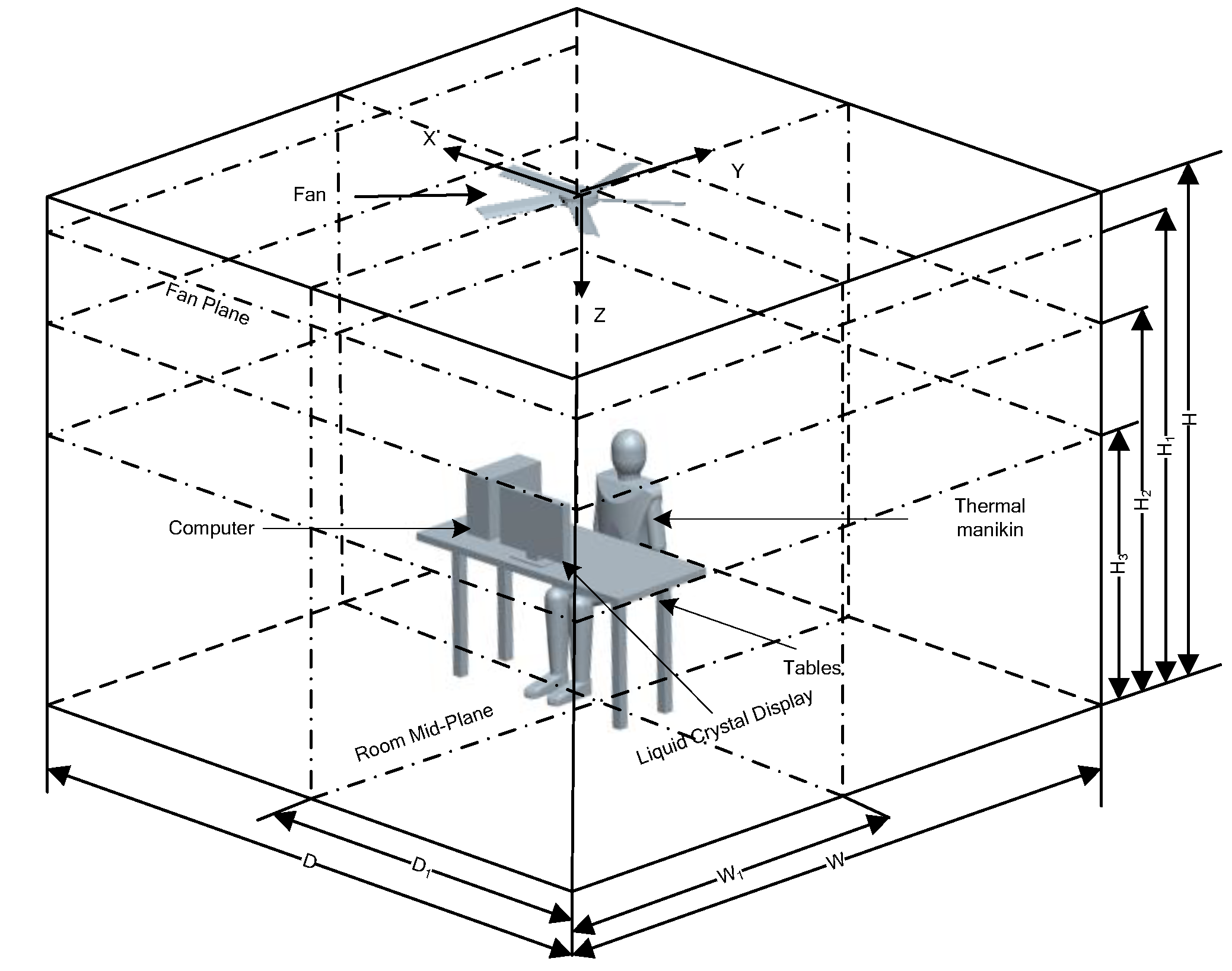

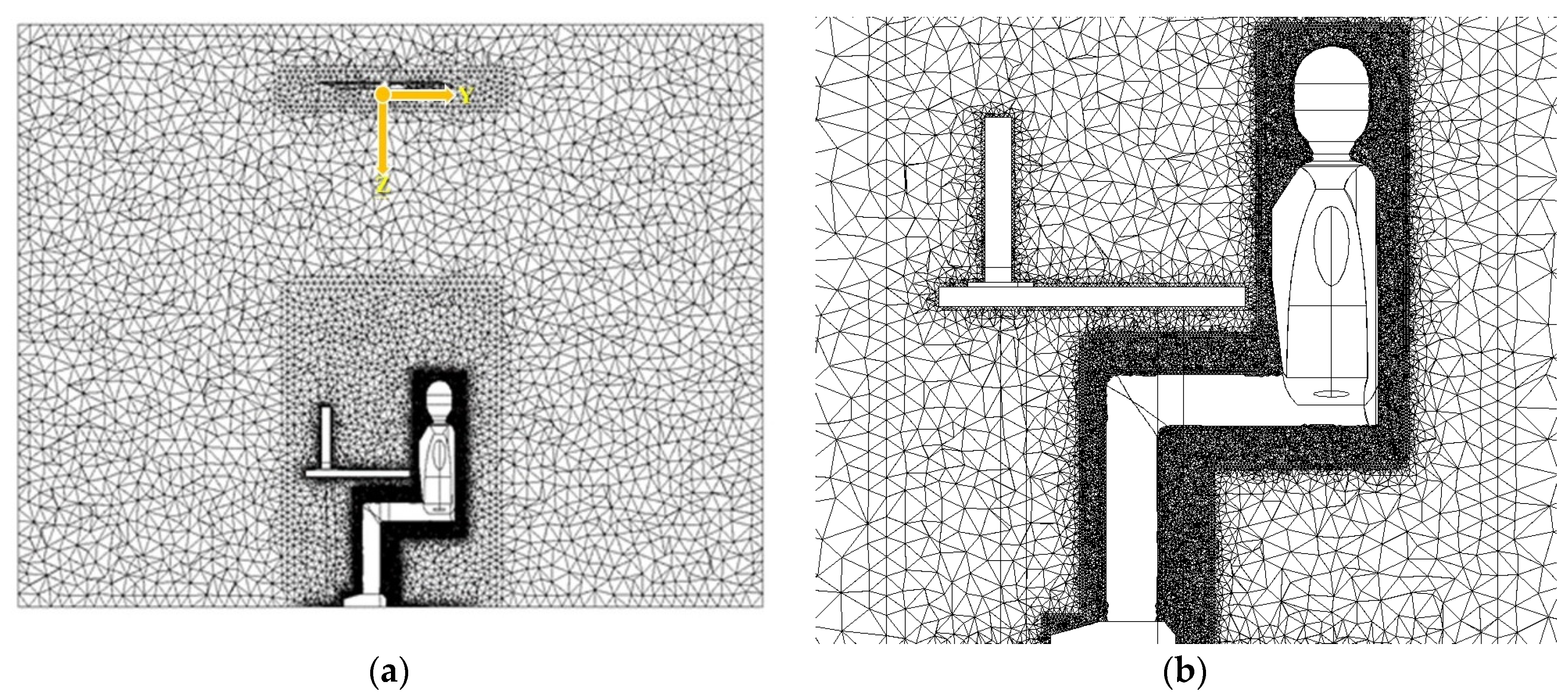
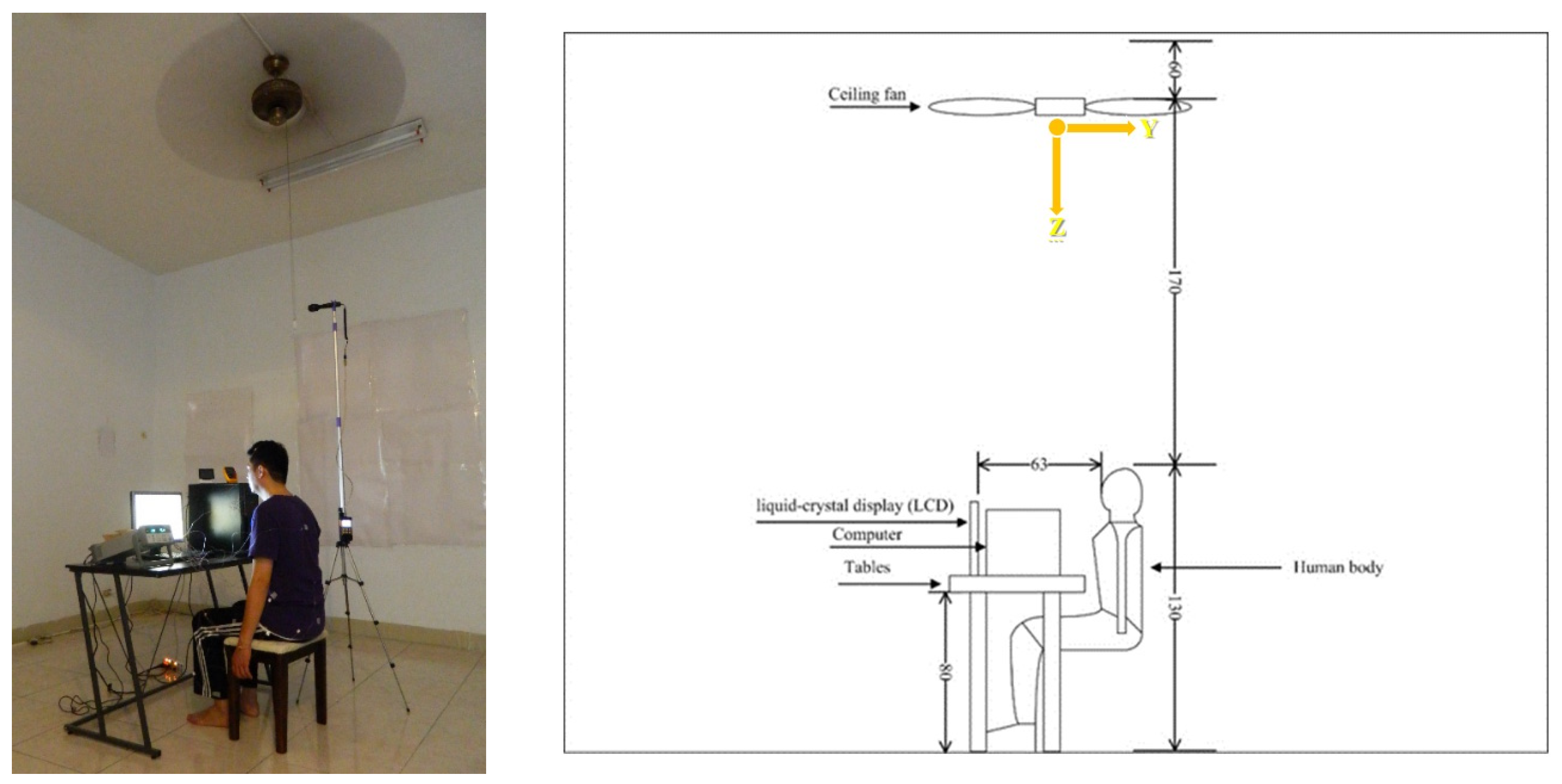
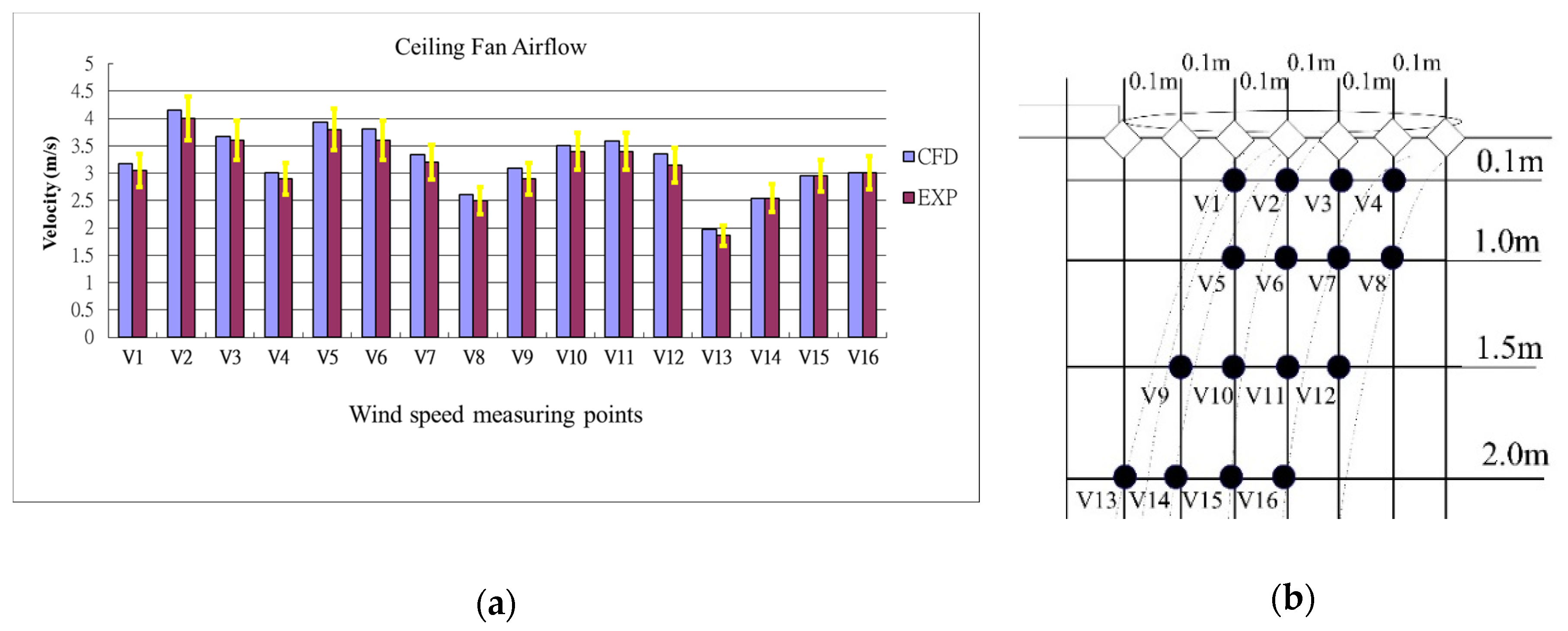
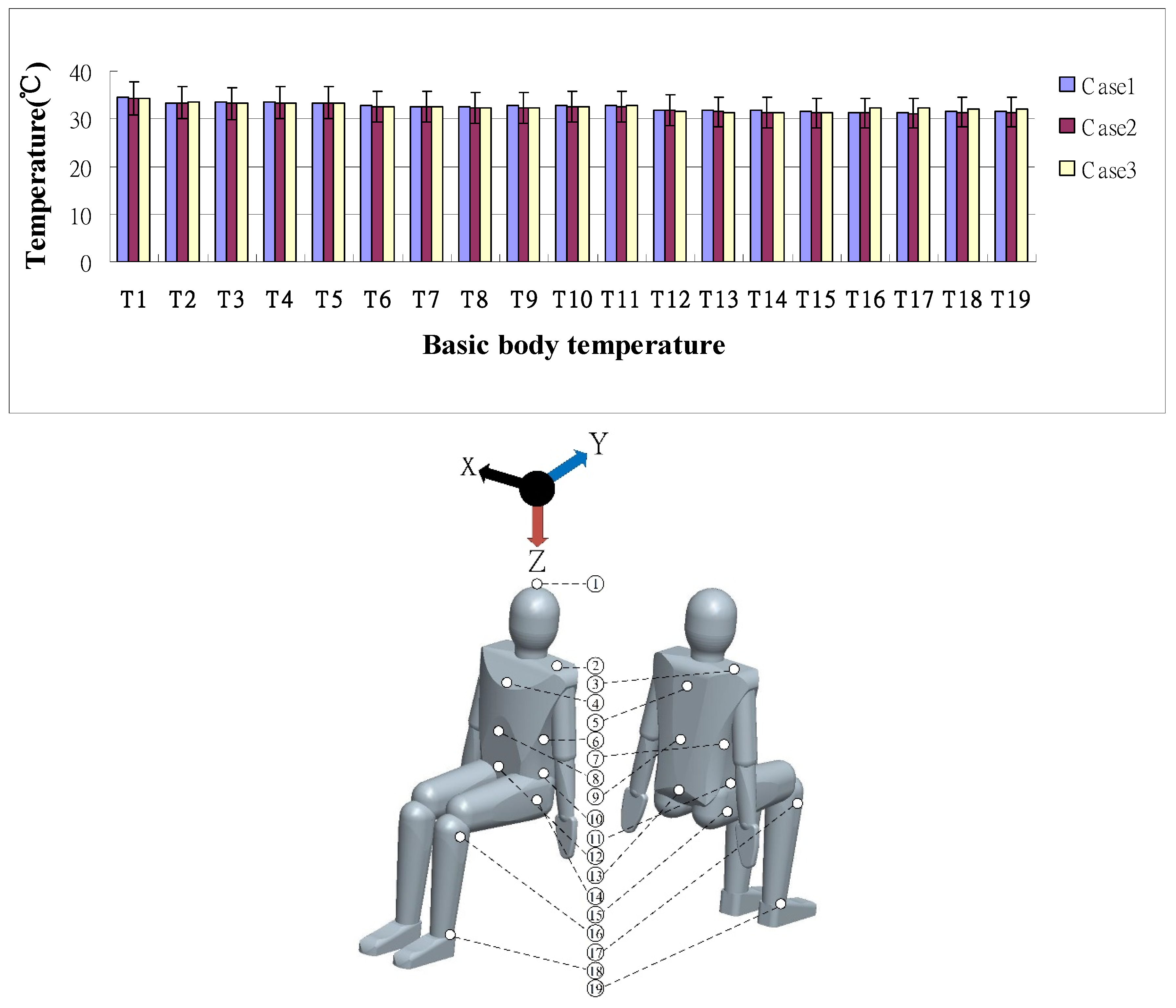
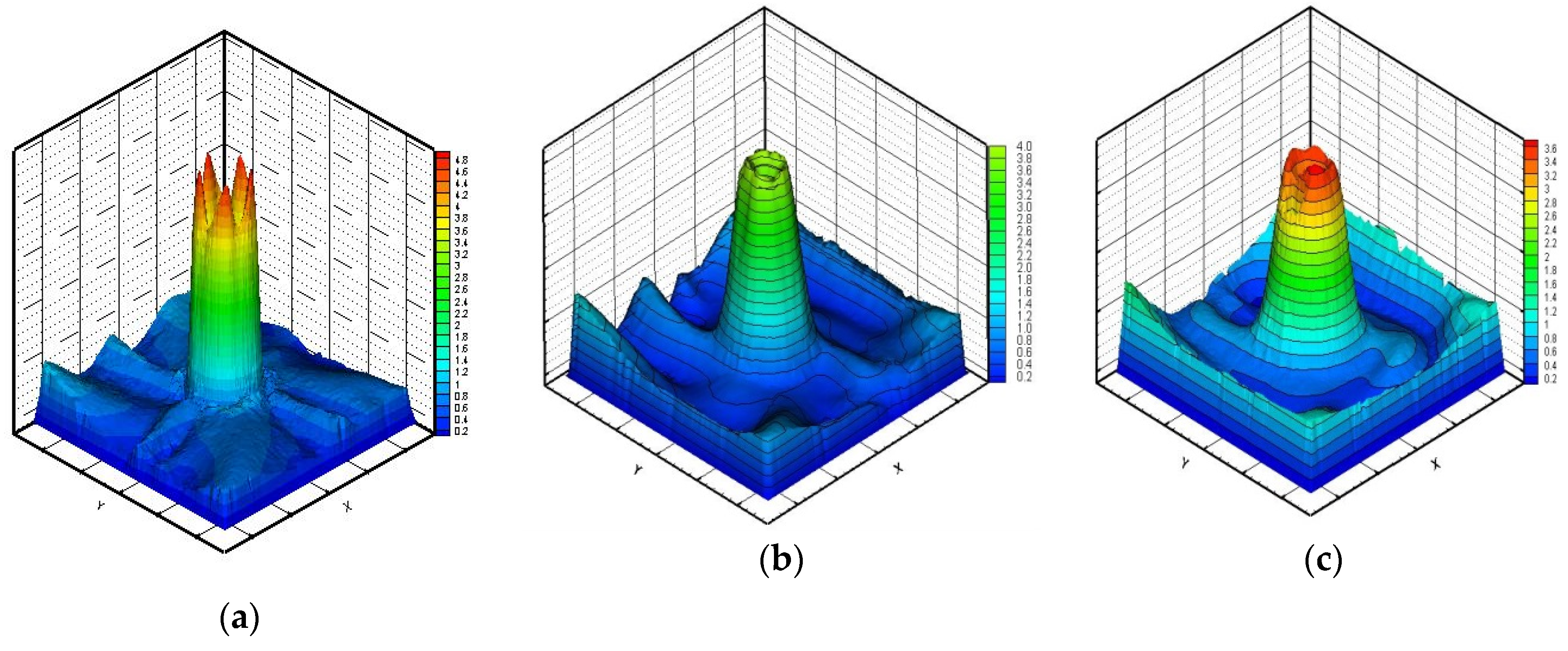
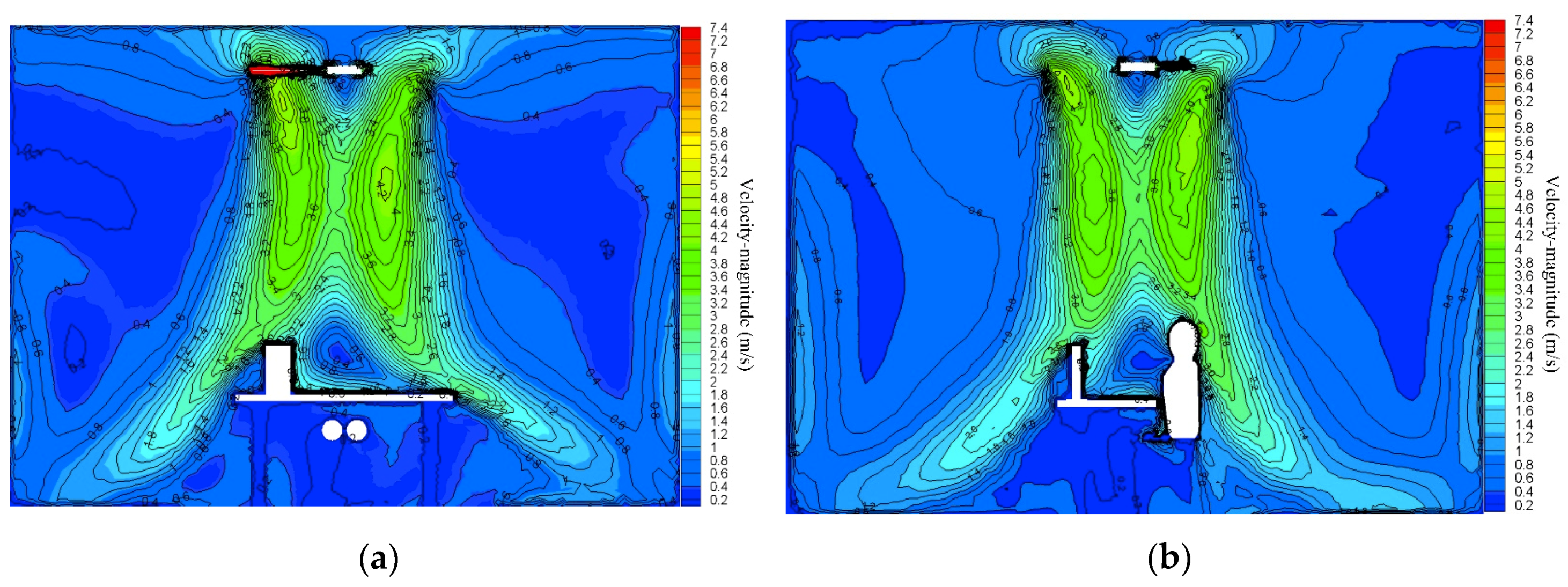
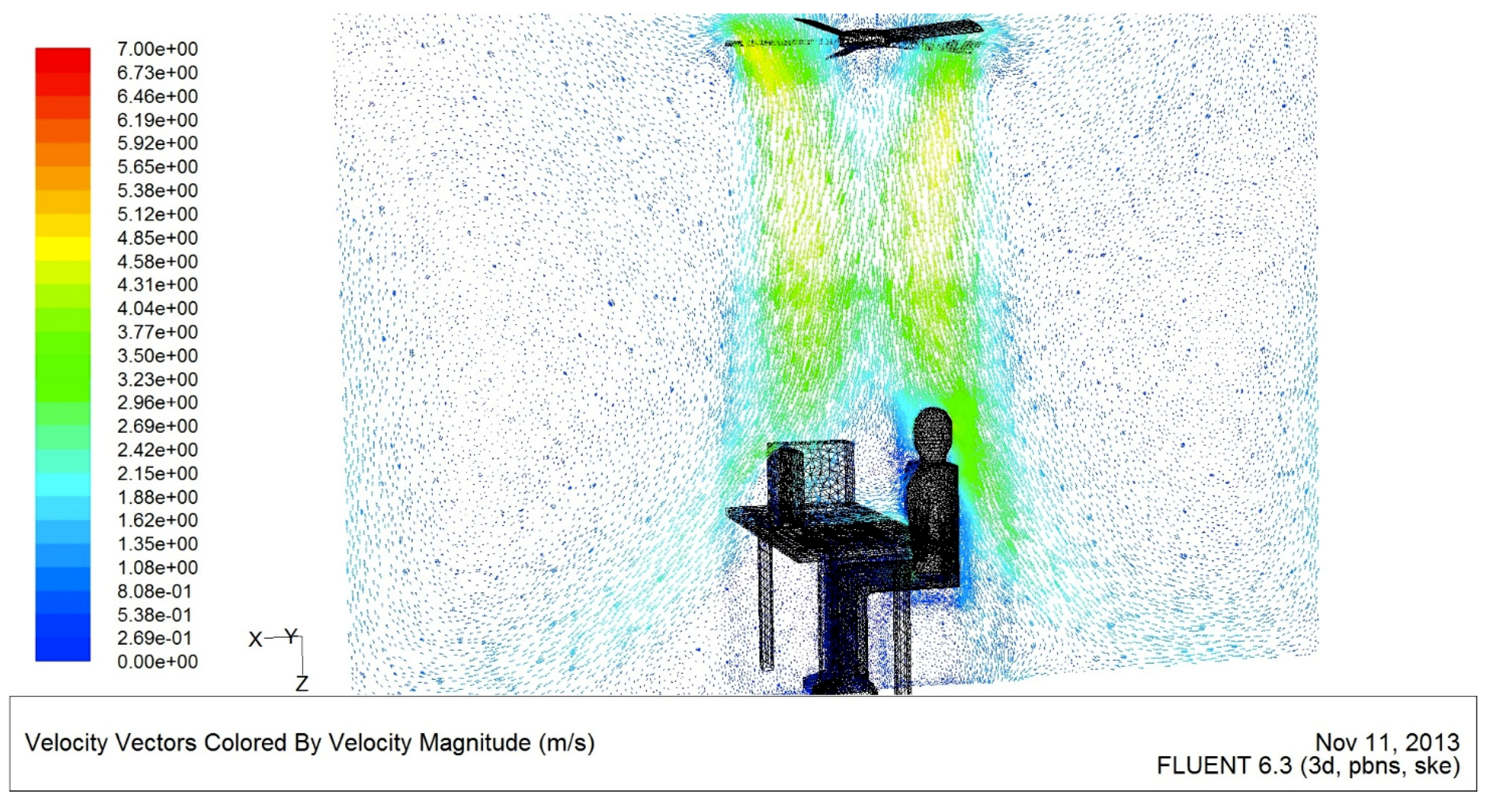
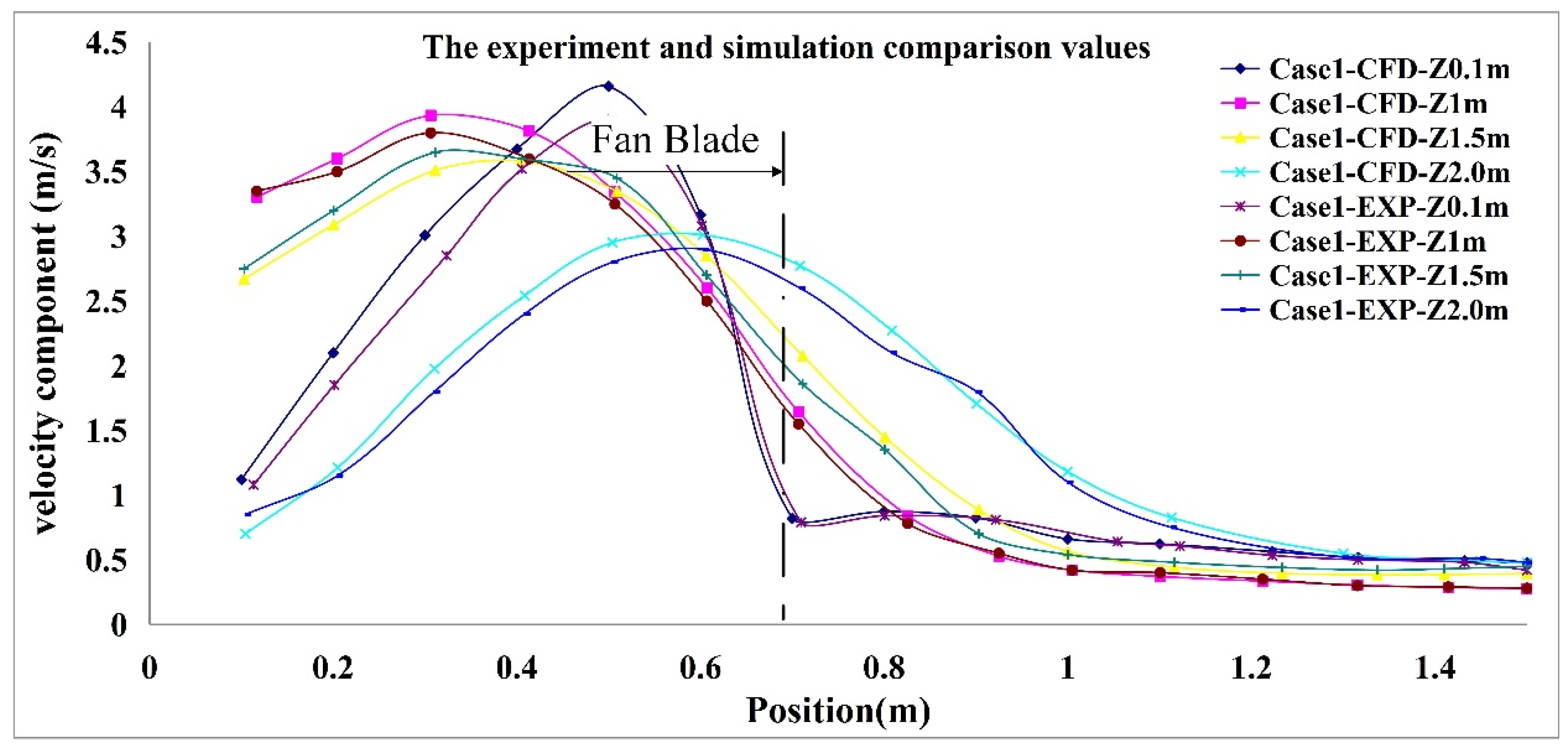
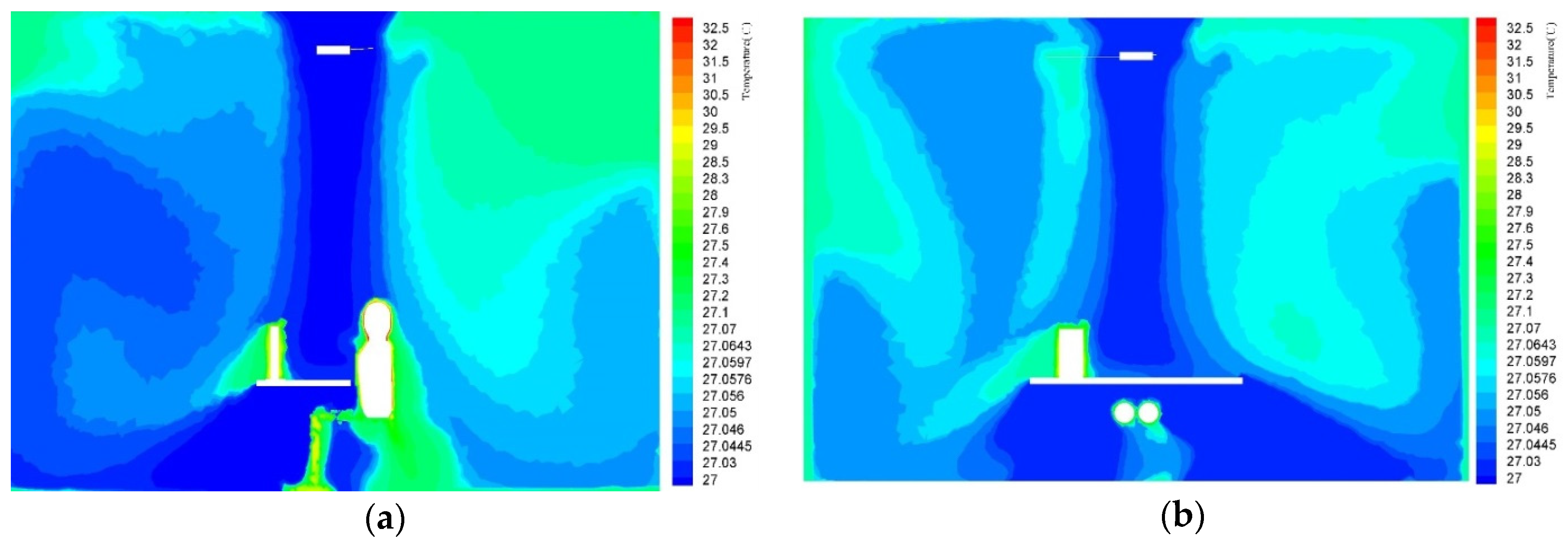


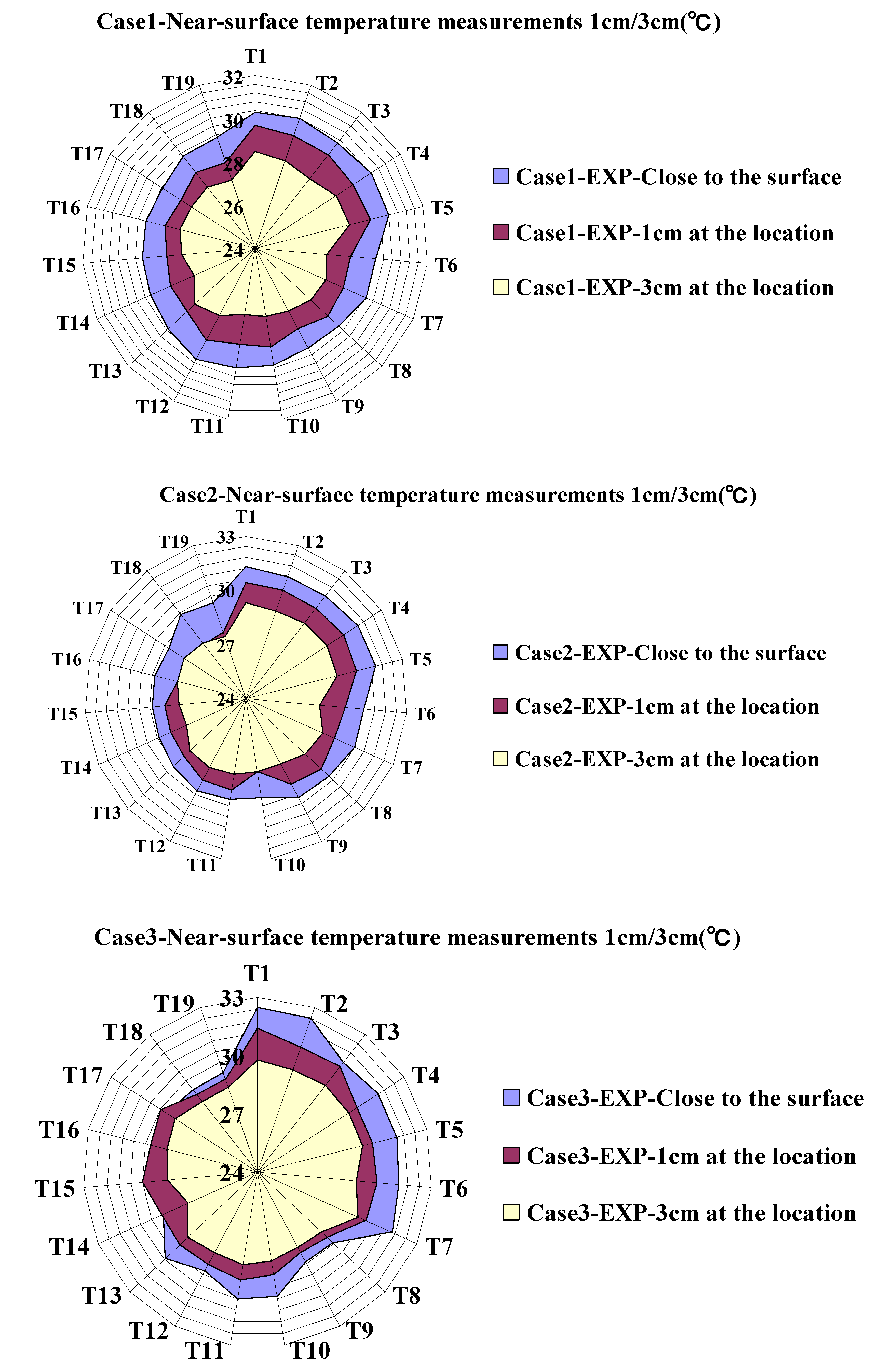
| Continuity | 1 |
|---|---|
| X-momentum | u |
| Y-momentum | v |
| Z-momentum | w |
| C1ε | Cu | Ck | ||
|---|---|---|---|---|
| 1.44 | 1.92 | 0.09 | 1.0 | 1.3 |
| Configuration of environment | Indoor conditions | Air temperature: 25 °C | ||
| Boundary conditions | No-slip condition | |||
| Pressure | Static pressure is 0 | |||
| Walls and furniture | Furniture, walls | No-slip condition Material: solid smooth surface Heat dissipation: none | ||
| Heat source | Mannequin | Heat dissipation: 70 W [12,22] | ||
| Computer | Heat dissipation: 93 W [22] | |||
| LCD monitor | Heat dissipation: 95 W [22] | |||
| Ceiling fan | Rotating boundary | The flow passages between fan blades are rotating around the fan’s origin of coordinates. The rotating speed is set as follows. | ||
| Case 1 | Case 2 | Case 3 | ||
| 240 RPM | 200 RPM | 160 RPM | ||
| Fixed boundary | Fluid needs to satisfy both the impermeable condition and the no-slip condition at walls. | |||
| (a) Body | Temperature measuring points | |||||||||||||||||||
| 1 | 2 | 3 | 4 | 5 | 6 | 7 | 8 | 9 | 10 | 11 | 12 | 13 | 14 | 15 | 16 | 17 | 18 | 19 | ||
| Terminal temp (°C) | EXP | 32.5 | 32.4 | 31.2 | 31.4 | 31.4 | 31.3 | 31.6 | 29.3 | 29.2 | 30.5 | 30.6 | 29.8 | 30.5 | 29.3 | 29.6 | 29.6 | 29.6 | 29.4 | 29.4 |
| CFD | 32.7 | 32.3 | 31.5 | 31.5 | 31.2 | 30.8 | 30.5 | 30.5 | 30.7 | 30.7 | 30.8 | 30.9 | 30.7 | 29.8 | 29.5 | 29.3 | 29.3 | 29.8 | 29.8 | |
| Terminal velocity (m/s) | EXP | 1.34 | 1.07 | 0.92 | 0.81 | 1.01 | 0.39 | 0.37 | 0.50 | 0.41 | 0.31 | 0.23 | 0.49 | 0.37 | 0.25 | 0.17 | 0.15 | 0.11 | 0.09 | 0.09 |
| CFD | 1.38 | 1.03 | 0.93 | 0.82 | 0.98 | 0.37 | 0.38 | 0.51 | 0.43 | 0.33 | 0.26 | 0.48 | 0.37 | 0.26 | 0.21 | 0.13 | 0.11 | 0.08 | 0.09 | |
| (b) Computer | Temperature measuring points | |||||||||||||||||||
| 20 | 21 | 22 | 23 | |||||||||||||||||
| Terminal temp (°C) | EXP | 32.42 | 32.54 | 32.75 | 32.6 | |||||||||||||||
| CFD | 33.21 | 33.23 | 33.67 | 32.87 | ||||||||||||||||
| Terminal velocity (m/s) | EXP | 1.18 | 0.68 | 0.42 | 0.45 | |||||||||||||||
| CFD | 1.25 | 0.62 | 0.36 | 0.42 | ||||||||||||||||
| (c) LCD monitor | Temperature measuring points | |||||||||||||||||||
| 24 | 25 | 26 | 27 | |||||||||||||||||
| Terminal temp (°C) | EXP | 31.6 | 31.4 | 31.8 | 32.3 | |||||||||||||||
| CFD | 32.4 | 32. 6 | 33.7 | 33.7 | ||||||||||||||||
| Terminal velocity (m/s) | EXP | 1.25 | 0.51 | 0.34 | 0.37 | |||||||||||||||
| CFD | 1.24 | 0.54 | 0.37 | 0.41 | ||||||||||||||||
© 2019 by the author. Licensee MDPI, Basel, Switzerland. This article is an open access article distributed under the terms and conditions of the Creative Commons Attribution (CC BY) license (http://creativecommons.org/licenses/by/4.0/).
Share and Cite
Lin, H.-H. Improvement of Human Thermal Comfort by Optimizing the Airflow Induced by a Ceiling Fan. Sustainability 2019, 11, 3370. https://doi.org/10.3390/su11123370
Lin H-H. Improvement of Human Thermal Comfort by Optimizing the Airflow Induced by a Ceiling Fan. Sustainability. 2019; 11(12):3370. https://doi.org/10.3390/su11123370
Chicago/Turabian StyleLin, Hsin-Hung. 2019. "Improvement of Human Thermal Comfort by Optimizing the Airflow Induced by a Ceiling Fan" Sustainability 11, no. 12: 3370. https://doi.org/10.3390/su11123370
APA StyleLin, H.-H. (2019). Improvement of Human Thermal Comfort by Optimizing the Airflow Induced by a Ceiling Fan. Sustainability, 11(12), 3370. https://doi.org/10.3390/su11123370





